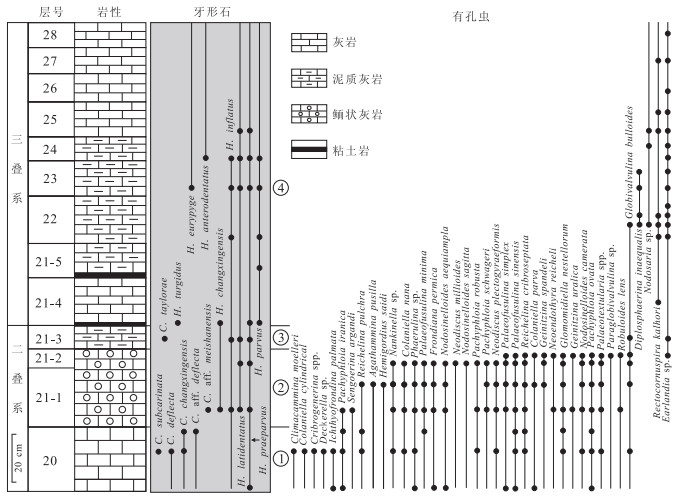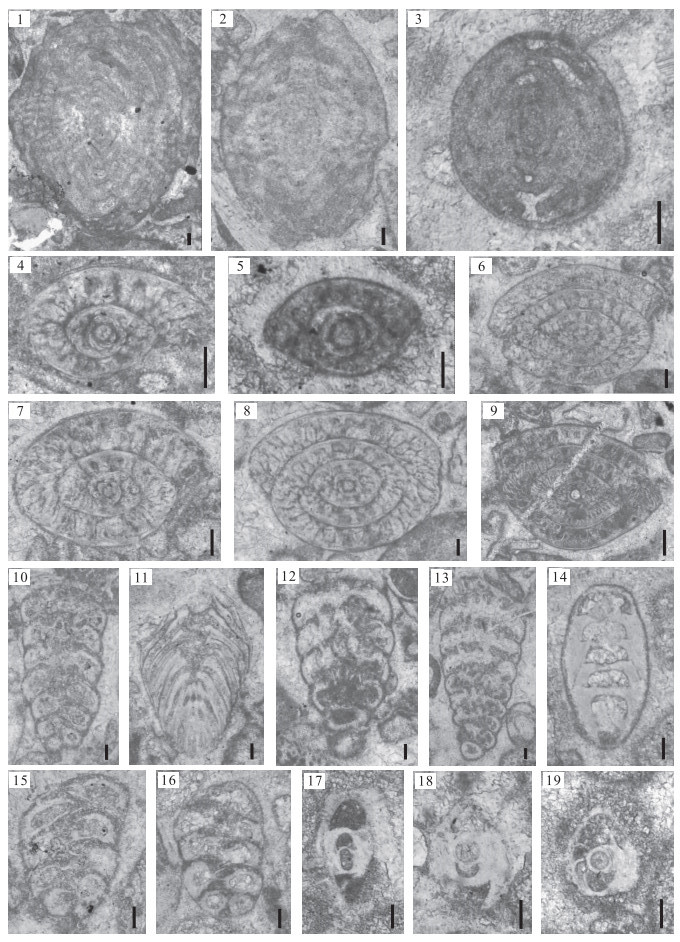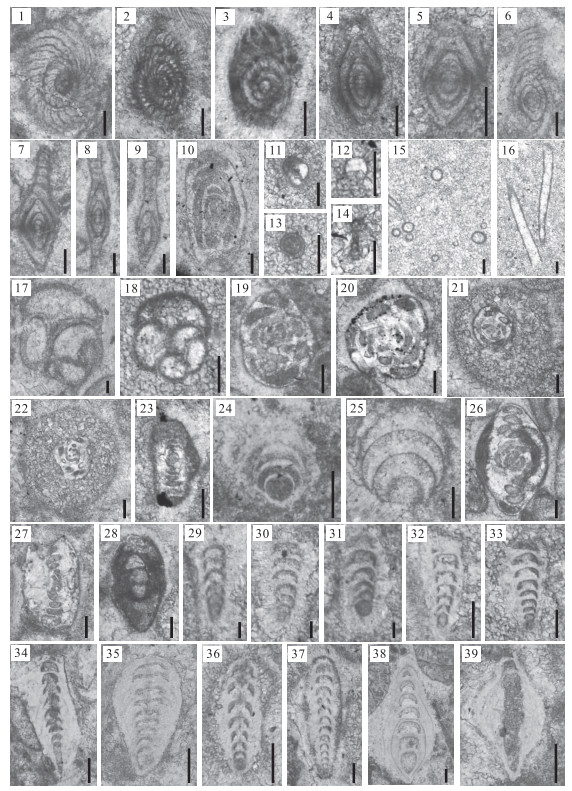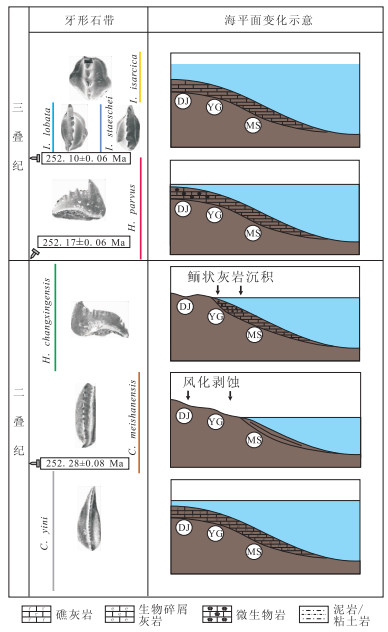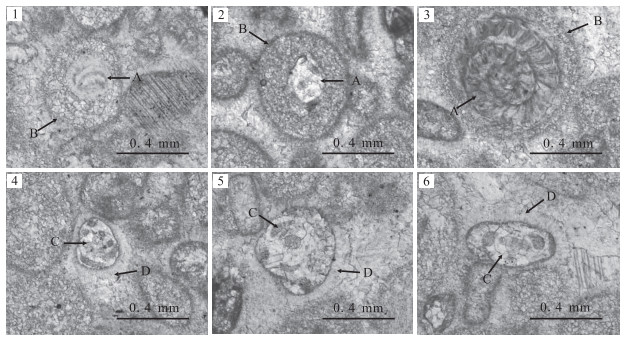Foraminiferal Evolution and Formation of Oolitic Limestone near Permian-Triassic Boundary at Yangou Section, Jiangxi Province
-
摘要: 江西乐平沿沟剖面均一的碳酸盐相岩沉积, 完整地记录了二叠系-三叠系界线附近生物演变过程.通过对该剖面系统的化石切片研究, 共鉴别出有孔虫27属39种, 包含类4属7种.该剖面有孔虫的演变在二叠纪-三叠纪之交呈现出单幕式的消减过程, 对应于华南两幕生物灭绝中的第1幕.有孔虫的个体数和多样性在21-2层顶部发生了突然降低.4个不同有孔虫组合的演替关系, 揭示了有孔虫在灭绝事件中的演变过程, 即由灭绝前的高丰度、高分异度组合转变为灭绝后低丰度、低分异度组合.通过对二叠系-三叠系界线处鲕状灰岩的化石和沉积特征研究, 发现Hindeodus changxingensis带内的鲕状灰岩中仍存在较为丰富的有孔虫等化石.剧烈的海平面变化以及鲕状灰岩形成使下伏地层中的化石颗粒发生再沉积作用, 是形成这一特殊现象的主要原因.通过对鲕状灰岩中化石和沉积特征的深入研究, 论证了该鲕状灰岩形成于二叠纪-三叠纪之交大灭绝之后, 是当时特殊的海洋生态系产物, 反映了当时较高的海水回旋速率、微生物繁盛、海水碳酸盐超饱和等异常的环境条件.Abstract: The homogeneous carbonate Permian-Triassic boundary section at Yangou records the integrated extinction process of the shallow marine area, which killed over 90% marine invertebrates. This study of foraminifers explores the extinction pattern and deposition progress during the Paleozoic-Mesozoic transition. In total, 39 species in 27 genera of foraminifers have been identified, including 7 species in 4 genera of fusulinids. The richness and diversity remarkably decrease at the top of Bed 21-2, marking the disappearance horizon. 4 distinct assemblages evolved within the Permian-Triassic boundary beds: the assemblages with low richness and low disparity replaced those with high richness and high disparity. The diversity and assemblage analysis exhibit a rapid decline process at the top of Bed 21-2. Whereas, the mixing of pre-extinction fauna, fusulinids, with post-extinction fauna, Hindeodus changxingensis, within the oolitic beds, implies that the fossil could be reworked to the shoal by the sea level changes. Meanwhile, the coating of foraminifers and aragonite-calcite cement around the grains indicate a catastrophic ocean with high water velocity, elevated microbes and carbonate super-saturation.
-
Key words:
- Permian-Triassic /
- foraminifer /
- extinction /
- Yangou Section /
- paleontology
-
图 2 沿沟剖面二叠系-三叠系界线附近(20层-28层)的牙形石和有孔虫化石分布
牙形石数据引自Sun et al.(2012).①Clarkina yini-Clarkina zhangi带;②Hindeodus changxingensis带;③Clarkina taylorae带;④Hindeodus parvus带
Fig. 2. The distribution of foraminifers and conodonts at Yangou section (Bed 20 to Bed 28)
图 4 沿沟二叠纪-三叠纪之交有孔虫群落组成
a.Palaeofusulina sinensis-Glomomidiella nestellorum组合;b.Glomomidiella nestellorum组合;c.Earlandia sp.-Globivalvulina bulloides组合;d.Earlandia sp.-Rectocornuspira kalhori组合.Earlandia sp.-Rectocornuspira kalhori组合:产于21-4层到46层,其中发现有孔虫化石5属5种,共43枚,以Earlandia sp.和Rectocornuspira kalhori含量较高,相对丰度分别达到了55.8%和35.4%,同时还有Nodosaria sp.和Diplosphaerina inaequalis,相对丰度分别达到了5%和2.8%,另外还有约0.5%的Globivalvulina bulloides.该组合依据2个优势种命名,以低分异度和低丰度为特征
Fig. 4. The composition of foraminifer assemblages near the Permian-Triassic boundary at Yangou section
图 5 沿沟剖面二叠系-三叠系界线附近地层中有孔虫化石
图中线条比例尺长度为0.1mm.1~2.Nankinella sp.;1.LY201028,弦切面,产自20层;2.LY20544,弦切面,产自20层;3.Sphaerulina sp., LY21522,旋切面,产自21层;4.Palaeofusulina minima, LY20038,轴切面,产自20层;5.Palaeofusulina simplex, LY21125,近轴切面,产自21层;6~9.Palaeofusulina sinensis,LY205113,弦切面,产自20层;7.LY20016,近轴切面,产自10层;8.LY20514,轴切面,产自20层;9.LY205131,轴切面,产自20层;10.Climacammina moelleri, LY205328,纵切面,产自20层;11.Colaniella nana, LY20518,斜切面,产自20层;12~13.Cribrogenerina spp.;12.LY205130,纵切面,产自20层;13.LY205316,纵切面,产自20层;14.Pachyphloia robusta, LY212114,纵切面,产自21-2层;15~16.Palaeotextularia spp.;15.LY20532,纵切面,产自20层;16.LY212130,纵切面,产自21-2层;17~18.Robuloides lens;17.LY211211,纵切面,产自21-1层;18.LY212315,纵切面,产自21-2层;19.LY212326,纵切面,产自21-2层
Fig. 5. Foraminifer fossils from the Permian-Triassic boundary strata at Yangou section
图 6 沿沟剖面二叠系-三叠系界线附近地层中有孔虫化石
图中比例尺长度为0.1mm.1~5.Reichelina cribroseptata;1.LY20223,近旋切面,产自20层;2.LY212415,斜切面,产自21-2层;3.LY21114,近旋切面,产自21-1层;4.LY211210,弦切面,产自21-1层;5.LY21122,近轴切面,产自21-1层;6~9.Reichelina purlchra;6.LY20041,近轴切面,产自20层;7.LY20522,轴切面,产自20层;8.LY20527,弦切面,产自20层;9.LY205121,弦切面,产自20层;10.Agathammina pusilla,LY21121,横切面,产自21-1层;11~12.Diplosphaerina inaequalis;11.LY2255,球切面,产自22层;12.LY23123,球切面,产自23层;13~14.Rectocornuspira kalhori;13.LY2321,球切面,产自23层;14.LY2285,纵切面,产自22层;15~16.Earlandia sp.;15.LY2321,球切面,产自23层;16.LY2311,纵切面,产自23层;17~18.Globivalvulina bulloides;17.LY205310,纵切面,产自20层;18.LY2251,纵切面,产自22层;19~22.Glomomidiella nestellorum;19.LY20515,球切面,产自20层;20.LY21146,球切面,产自21-1层;21.LY211432,球切面,产自21-1层;22. LY212414,球切面,产自21-2层;23.Hemigordius saidi LY211118,纵切面,产自21-1层;24~25.Ichthyofrondina palmate;24.LY20532,纵切面,产自20层;25.LY201014,纵切面,产自20层;26~27.Neodiscus milliloides;26.LY205134,纵切面,产自20层;27.LY21223,纵切面,产自21-2层;28.Neoendothyra reicheli,LY211313,纵切面,产自21-1层;29~31.Nodosinelloides aequiampla;29.LY21116,纵切面,产自21-1层;30.LY211213,纵切面,产自21-1层;31.LY211428,纵切面,产自21-1层;32~33.Nodosinelloides camerata;32.LY21112,纵切面,产自21-1层;33.LY211428,纵切面,产自21-1层;34.Pachyphloia iranica,LY20516,纵切面,产自20层;35.Pachyphloia ovate,LY2010313,纵切面,产自20层;36~37.Pachyphloia schwageri;36.LY21123,纵切面,产自21-1层;37.LY212517,纵切面,产自21-2层;38~39.Pachyphloia spp.;38.LY205323,纵切面,产自20层;39.LY205410,纵切面,产自20层
Fig. 6. Foraminifer fossils from the Permian-Triassic boundary strata at Yangou section
图 7 沿沟及邻区二叠纪-三叠纪之交沉积演变示意
DJ.打讲剖面;YG.沿沟剖面;MS.煤山剖面.测年数据引自Shen et al.(2011a),牙形石带和照片引自Jiang et al.(2007)及Sun et al.(2012)
Fig. 7. The model of the depositional progresses during the Permian-Triassic transition
表 1 沿沟剖面二叠纪-三叠纪之交有孔虫分布统计
Table 1. Distribution of foraminifers near the Permian-Triassic boundary at Yangou section

-
Algeo, T.J., Chen, Z.Q., Fraiser, M.L., et al., 2011. Terrestrial-Marine Teleconnections in the Collapse and Rebuilding of Early Triassic Marine Ecosystems. Palaeogeography, Palaeoclimatology, Palaeoecology, 308(1-2): 1-11. doi: 10.1016/j.palaeo.2011.01.011 Algeo, T.J., Ellwood, B., Nguyen, T.K.T., et al., 2007. The Permian-Triassic Boundary at Nhi Tao, Vietnam: Evidence for Recurrent Influx of Sulfidic Watermasses to a Shallow-Marine Carbonate Platform. Palaeogeography, Palaeoclimatology, Palaeoecology, 252(1-2): 304-327. doi: 10.1016/j.palaeo.2006.11.055 Algeo, T.J., Twitchett, R.J., 2010. Anomalous Early Triassic Sediment Fluxes due to Elevated Weathering Rates and Their Biological Consequences. Geology, 38(11): 1023-1026. doi: 10.1130/G31203.1 Becker, L., Poreda, R.J., Hunt, A.G., et al., 2001. Impact Event at the Permian-Triassic Boundary: Evidence from Extraterrestrial Noble Gases in Fullerenes. Science, 291(5508): 1530-1533. doi: 10.1126/science.1057243 Buggisch, W., Noe, S., 1986. Upper Permian and Permian-Triassic Boundary of the Carnia (Bellerophon Formation, Tesero Horizon, Northern Italy). Memorie Della Societa Geologica Italiana, 34: 91-106. http://work.geobiology.cn/ebook/MEMORIE%20DELLA%20SOCIETA%20GEOLOGICA%20ITALIANA/05.UPPER%20PERMIAN%20AND%20PERMIAN-TRIASSIC%20BOUNDARY%20OF%20THE%20CARNIA%20(BELLEROPHON%20FORMATION,%20TESERO%20HORIZON,%20NORTHERN%20ITALY).pdf Campbell, I.H., Czamanske, G.K., Fedorenko, V.A., et al., 1992. Synchronism of the Siberian Traps and the Permian-Triassic Boundary. Science, 258(5089): 1760-1763. doi: 10.1126/science.258.5089.1760 Cao, C.Q., Zheng Q.F., 2009. Geological Event Sequences of the Permian-Triassic Transition Recorded in the Microfacies in Meishan Section. Science in China (Series D), 39(4): 481-487 (in Chinese). doi: 10.1007/s11430-009-0113-0 Collin, P., Kershaw, S., Crasquin-Soleau, S., et al., 2009. Facies Changes and Diagenetic Processes across the Permian-Triassic Boundary Event Horizon, Great Bank of Guizhou, South China: A Controversy of Erosion and Dissolution. Sedimentology, 56(3): 677-693. doi: 10.1111/j.1365-3091.2008.00992.x Erwin, D.H., 1994. The Permo-Triassic Extinction. Nature, 367(6460): 231-236. doi: 10.1038/367231a0 Flügel, E., 2004. Microfacies of Carbonate Rocks: Analysis, Interpretation and Application. Springer, Berlin, 1-976. Groves, I.R., 2004. Lower Triassic Oolites in Tethys: A Sedimentologic Response to the End-Permian Mass Extinction. GSA Annual Meeting Paper, 36(5): 336. http://www.researchgate.net/publication/284057031_Lower_Triassic_oolites_in_Tethys_A_sedimentologic_response_to_the_end-Permian_mass_extinction Groves, J.R., Altiner, D., Rettori, R., 2005. Extinction, Survival, and Recovery of Lagenide Foraminifers in the Permian-Triassic Boundary Interval, Central Taurides, Turkey. Journal of Paleontology, 79(SP62): 1-38. doi: 10.1666/0022-3360(2005)79[1:ESAROL]2.0.CO;2 Groves, J.R., Rettori, R., Payne, J.L., et al., 2007. End-Permian Mass Extinction of Lagenide Foraminifers in the Southern Alps (Northern Italy). Journal of Paleontology, 81(3): 415-434. doi: 10.1666/05123.1 Gu, S.Z., Pei, J.C., Yang, F.Q., et al., 2002. Smaller Foraminifera Fauna from the Changxingian of the Sidazhai Section, Ziyun County, Southern Guizhou Province. Acta Micropalaeotologica Sinica, 19(2): 163-169 (in Chinese with English abstract). http://europepmc.org/abstract/CBA/374613 Gu, S.Z., Peng, F., He, W.H., et al., 2005. Shallow Water Smaller Foraminifera from the Upper Permian of the Liuqiao Area, Southwestern Guangxi, South China. Acta Micropalaeotologica Sinica, 22(2): 163-172 (in Chinese with English abstract). http://en.cnki.com.cn/Article_en/CJFDTOTAL-WSGT200502005.htm Hallam, A., Wignall, P.B., 1999. Mass Extinctions and Sea-Level Changes. Earth-Science Reviews, 48(4): 217-250. doi: 10.1016/S0012-8252(99)00055-0 Jiang, H.S., Lai, X.L., Luo, G.M., et al., 2007. Restudy of Conodont Zonation and Evolution across the P/T Boundary at Meishan Section, Changxing, Zhejiang, China. Global and Planetary Change, 55(1-3): 39-55. doi: 10.1016/j.gloplacha.2006.06.007 Jin, Y.G., Wang, Y., Wang, W., et al., 2000. Pattern of Marine Mass Extinction near the Permian-Triassic Boundary in South China. Science, 289(5478): 432-436. doi: 10.1126/science.289.5478.432 Kaiho, K., Kajiwara, Y., Nakano, T., et al., 2001. End-Permian Catastrophe by a Bolide Impact: Evidence of a Gigantic Release of Sulfur from the Mantle. Geology, 29(9): 815-818. doi: 10.1130/0091-7613(2001) Lehrmann, D.J., Minzoni, M., Li, X.W., et al., 2012. Lower Triassic Oolites of the Nanpanjiang Basin, South China: Facies Architecture, Giant Ooids, and Diagenesis—Implications for Hydrocarbon Reservoirs. AAPG Bulletin, 96(8): 1389-1414. doi: 10.1306/01231211148 Li, F., Yan, J.X., Algeo, T.J., et al., 2013. Paleoceanographic Condition Following the End-Permian Mass Extinction Recorded by Giant Ooids (Moyang, South China). Global and Planetary Change, 105: 102-120. doi: 10.1016/j.gloplacha.2011.09.009 Marcoux, J., Baud, A., 1986. The Permo-Triassic Boundary in the Antalya Nappes (Western Taurides, Turkey). Memorie Della Societa Geologica Italiana, 34: 243-252 http://www.researchgate.net/publication/235007478_The_Permo-Triassic_boundary_in_the_Antalya_Nappes_Western_Taurides_-_Turkey_-/download Metcalfe, I., Nicoll, S.R., Wardlaw, R.B., 2007. Conodont Index Fossil Hindeodus changxingensis Wang Fingers Greatest Mass Extinction Event. Palaeoworld, 16(1-3): 202-207. doi: 10.1016/j.palwor.2007.01.001 Payne, J.L., Turchyn, T.A., Paytan, A., et al., 2010. Calcium Isotope Constraints on the End-Permian Mass Extinction. Proceedings of National Academy of Science, USA, 107(19): 8543-8548. doi: 10.1073/pnas.0914065107 Raup, D.M., 1979. Size of the Permian-Triassic Bottleneck and Its Evolutionary Implications. Science, 206(4415): 217-218. doi: 10.1126/science.206.4415.217 Raup, D.M., Sepkoski, J.J.J., 1982. Mass Extinctions in the Marine Fossil Record. Science, 215(4539): 1501-1503. doi: 10.1126/science.215.4539.1501 Reichow, M.K., Pringle, M.S., Al'Mukhamedov, A.I., et al., 2009. The Timing and Extent of the Eruption of the Siberian Traps Large Province: Implications for the End-Permian Environmental Crisis. Earth and Planetary Science Letters, 277(1-2): 9-20. doi: 10.1016/j.epsl.2008.09.030 Renne, P.R., Basu, A.R., 1991. Rapid Eruption of the Siberian Traps Flood Basalts at the Permo-Triassic Boundary. Science, 253(5016): 176-179. doi: 10.1126/science.253.5016.176 Retallack, G.J., Jahren, A.H., 2008. Methane Release from Igneous Intrusion of Coal during Late Permian Extinction Events. The Journal of Geology, 116(1): 1-20. doi: 10.1086/524120 Saltzman, M.R., Sedlacek, A.R.C., 2013. Chemostratigraphy Indicates a Relatively Complete Late Permian to Early Triassic Sequence in the Western United States. Geology, 41(4): 399-402. doi: 10.1130/G33906.1 Shang, Q.H., Vachard, D., Caridroit, M., 2003. Smaller Foraminifera from the Late Changhsingian (Latest Permian) of Southern Guangxi and Discussion on the Permian-Triassic Boundary. Acta Micropalaeontologica Sinica, 20(4): 377-388 (in English with Chinese abstract). http://en.cnki.com.cn/Article_en/CJFDTOTAL-WSGT200304005.htm Shen, S.Z., Crowley, L.J., Wang, Y., et al., 2011. Calibrating the End-Permian Mass Extinction. Science, 334: 1367-1372. doi: 10.1126/science.1213454. Song, H.J., Tong, J.N., Chen, Z.Q., 2009a. Two Episodes of Foraminiferal Extinction near the Permian-Triassic Boundary at the Meishan Section, South China. Australian Journal of Earth Sciences, 56(6): 765-773. doi: 10.1080/08120090903002599 Song, H.J., Tong, J.N., Chen, Z.Q., et al., 2009b. End-Permian Mass Extinction of Foraminifers in the Nanpanjiang Basin, South China. Journal of Paleontology, 83(5): 718-738. doi: 10.1666/08-175.1 Song, H.J., Tong, J.N., He, W.H., 2006. Latest Permian Small Foraminiferal Fauna at the Meishan Section, Zhejiang Province. Acta Micropalaeontologica Sinica, 23(2): 87-104 (in Chinese with English abstract). http://europepmc.org/abstract/CBA/620532 Song, H.J., Tong, J.N., Xiong, Y.L., et al., 2012. The Large Increase of δ13Ccarb-Depth Gradient and the End-Permian Mass Extinction. Science in China (Series D), 42(8): 1182-1191 (in Chinese). doi: 10.1007/s11430-012-4416-1 Song, H.J., Tong, J.N., Zhang, K.X., et al., 2007. Foraminifers Surviving from the End-Permian Mass Extinction at Meishan, Changxing, China. Palaeoworld, 22(1-3): 105-119. doi: 10.1016/j.palwor.2007.05.016 Song, H.J., Wignall, P.B., Tong, J.N., et al., 2012. Geochemical Evidence from Bio-Apatite for Multiple Oceanic Anoxic Events during Permian-Triassic Transition and the Link with End-Permian Extinction and Recovery. Earth and Planetary Science Letters, 353-354: 12-21. doi: 10.1016/j.epsl.2012.07.005 Song, H.J., Wignall, P.B., Tong, J.N., et al., 2013. Two Pulses of Extinction during the Permian-Triassic Crisis. Nature Geoscience, 6: 52-56. doi: 10.1038/ngeo1649 Sun, D.Y., Tong, J.N., Xiong, Y.L., et al., 2012. Conodont Biostratigraphy and Evolution across Permian-Triassic Boundary at Yangou Section, Leping, Jiangxi Province, South China. Journal of Earth Science, 23(3): 311-325. doi: 10.1007/s12583-012-0255-4 Sumner, D.Y., Grotzinger, J.P., 1993. Numerical Modeling of Ooid Size and the Problem of Neoproterozoic Giant Ooids. Journal of Sedimentary Research, 63(5): 974-982. doi: 10.1306/D4267C5D-2B2-11D7-8648000102C1865D Tian, L., Tong, J.N., Sun, D.Y., et al., 2014. The Microfacies and Sedimentary Responses to the Mass Extinction during the Permian-Triassic Transition at Yangou Section, Jiangxi Province, South China. Science in China (Series D), 57(9): 2195-2207. doi: 10.1007/s11430-014-4869-5 Tong, J.N., Kuang, W., 1990. A Study of the Changxingian Foraminifera and Microfacies in Liangfengya, Chongqing, Sichuan Province. Earth Science—Journal of China University of Geosciences, 15(3): 337-344 (in Chinese with English abstract). http://en.cnki.com.cn/Article_en/CJFDTOTAL-DQKX199003016.htm Tong, J.N., Shi, G.R., 2000. Evolution of the Permian and Triassic Foraminifera in South China. In: Yin, H.F., Dickins, J.M., Shi, G.R., et al., eds., Permian-Triassic Evolution of Tethys and Western Circum Pacific. Elsevier, Amsterdam, 291-307. Tong, J.N., Zuo, J.X., Chen, Z.Q., 2007. Early Triassic Carbon Isotope Excursions from South China: Proxies for Devastation and Restoration of Marine Ecosystems Following the End-Permian Mass Extinction. Geological Journal, 42(3-4): 371-389. doi: 10.1002/gj.1084 Wang, Q.X., Tong, J.N., Song, H.J., et al., 2009. Ecological Evolution across the Permian Triassic Boundary at the Kangjiaping Section in Cili County, Hunan Province, China. Science in China (Series D), 39(9): 1239-1247 (in Chinese). doi: 10.1007/s1143-009-0077-0 Wang, Y.B., Tong, J.N., Wang, J.S., et al., 2005. Calcimicrobialite after End-Permian Mass Extinction in South China and Its Palaeoenvironmental Significance. Chinese Science Bulletin, 50(6): 552-558 (in Chinese). doi: 10.1360/982004-323 Wignall, P.B., Kershaw, S., Collin, P., et al., 2009. Erosional Truncation of Uppermost Permian Shallow-Marine Carbonates and Implications for Permian-Triassic Boundary Events: Comment. Geological Society of America Bulletin, 121(5-6): 954-956. doi: 10.1130/B26424.1 Wignall, P.B., Twitchett, R.J., 1996. Oceanic Anoxia and the End Permian Mass Extinction. Science, 272(5265): 1155-1158. doi: 10.1126/science.272.5265.1155 Wignall, P.B., Twitchett, R.J., 2002. Extent, Duration, and Nature of the Permian-Triassic Superanoxic Event. In: Koeberl, C., MacLeod, K.C., eds., Catastrophic Events and Mass Extinctions: Impacts and Beyond. The Geological Society of America, Boulder, 356: 395-413. Woods, A.D., 2013. Microbial Ooids and Cortoids from the Lower Triassic (Spathian) Virgin Limestone, Nevada, USA: Evidence for an Early Triassic Microbial Bloom in Shallow Depositional Environments. Global and Planetary Change, 105: 91-101. doi: 10.1016/j.gloplacha.2012.07.011 Xie, S.C., Pancost, R.D., Wang, Y.B., et al., 2010. Cyanobacterial Blooms Tied to Vocanlism during the 5m. y. Permo-Triassic Biotic Crisis. Geology, 38(5): 447-450. doi: 10.1130/G30769.1 Xie, S.C., Richard, D.P., Yin, H.F., et al., 2005. Two Episodes of Microbial Change Coupled with Permian-Triassic Faunal Mass Extinction. Nature, 434: 494-497. doi: 10.1038/nature03396 Yang, H., Chen, Z.Q., Wang, Y.B., et al., 2011. Composition and Structure of Microbialite Ecosystems Following the End-Permian Mass Extinction in South China. Palaeogeography, Palaeoclimatology, Palaeoecology, 308(1-2): 111-128. doi: 10.1016/j.palaeo.2010.05.029 Yin, H.F., Jiang, H.S., Xia, W.C., et al., 2014. The End-Permian Regression in South China and Its Implication on Mass Extinction. Earth-Science Reviews, 137: 19-33. doi: 10.1016/j.earscierev.2013.06.003 Yin, H.F., Song, H.J., 2013. Mass Extinction and Pangea Integration during the Paleozoic-Mesozoic Transition. Science in China (Series D), 43: 1539-1552 (in Chinese). doi: 10.1007/s11430-013-4624-3 Yin, H.F., Xie, S.C., Luo, G.M., et al., 2012. Two Episodes of Environmental Change at the Permian-Triassic Boundary of the GSSP Section, Meishan. Earth-Science Reviews, 115(3): 163-172. doi: 10.1016/j.earscirev.2012.08.006 Zhu, X.S., Wang, C.Y., Lü, H., et al., 1994. Permian-Triassic Boundaries in Jiangxi, China. Acta Micropalaeontologica Sinica, 11(4): 439-452 (in Chinese with English abstract). http://en.cnki.com.cn/Article_en/CJFDTOTAL-WSGT404.004.htm 曹长群, 郑全锋, 2009. 煤山二叠纪-三叠纪过渡期事件地层时序的微观地层记录. 中国科学(D辑), 39(4): 481-487. https://www.cnki.com.cn/Article/CJFDTOTAL-JDXK200904011.htm 顾松竹, 裴景成, 杨逢清, 等, 2002. 黔南紫云四大寨长兴期小有孔虫. 微体古生物学报, 19(2): 163-169. doi: 10.3969/j.issn.1000-0674.2002.02.006 顾松竹, 彭凡, 何卫红, 等, 2005. 桂西南柳桥地区二叠纪末期浅水相小有孔虫动物群. 微体古生物学报, 22(2): 163-172. doi: 10.3969/j.issn.1000-0674.2005.02.006 尚庆华, 瓦夏德, D., 卡里杜瓦, M., 2003. 广西南部晚长兴期小型有孔虫及二叠系-三叠系界线讨论. 微体古生物学报, 20(4): 377-388. doi: 10.3969/j.issn.1000-0674.2003.04.006 宋海军, 童金南, 何卫红, 2006. 浙江煤山剖面二叠纪末的小有孔虫动物群. 微体古生物学报, 23(2): 87-104. doi: 10.3969/j.issn.1000-0674.2006.02.001 宋海军, 童金南, 熊炎林, 等, 2012. δ13Ccarb-深度梯度的剧增与二叠纪末生物大灭绝. 中国科学(D辑), 42 (8): 1182-1191. https://www.cnki.com.cn/Article/CJFDTOTAL-JDXK201208005.htm 童金南, 匡文, 1990. 四川重庆凉风垭长兴期有孔虫动物群及微相. 地球科学——中国地质大学学报, 15(3): 337-344. https://www.cnki.com.cn/Article/CJFDTOTAL-DQKX199003016.htm 王钦贤, 童金南, 宋海军, 等, 2009. 湖南慈利康家坪剖面二叠纪-三叠纪之交的生态系演变. 中国科学(D辑), 39(9): 1239-1247. https://www.cnki.com.cn/Article/CJFDTOTAL-JDXK200909009.htm 王永标, 童金南, 王家生, 等, 2005. 华南二叠纪末大灭绝后的钙质微生物岩及古环境意义. 科学通报, 50(6): 552-558. doi: 10.3321/j.issn:0023-074X.2005.06.009 殷鸿福, 宋海军, 2013. 古、中生代之交生物大灭绝与泛大陆聚合. 中国科学(D辑), 43: 1539-1552. https://www.cnki.com.cn/Article/CJFDTOTAL-JDXK201310002.htm 朱相水, 王成源, 吕桦, 等, 1994. 江西二叠-三叠系界线. 微体古生物学报, 11(4): 439-452. https://www.cnki.com.cn/Article/CJFDTOTAL-WSGT404.004.htm -









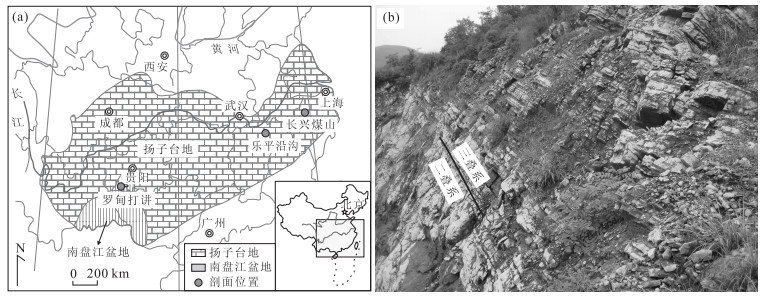
 下载:
下载:
